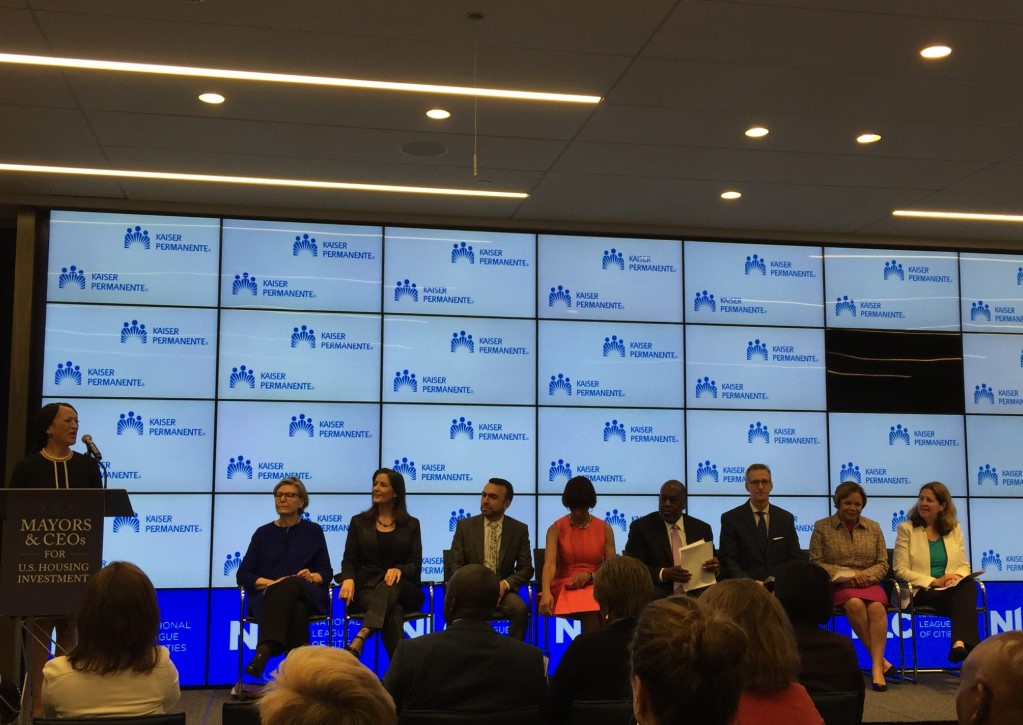 Recently, Benjamin K. Chu, MD, MPH, MACP, group president for Kaiser Permanente Southern California and Kaiser Permanente Hawaii, spoke at his investiture as chair of the American Hospital Association. The AHA represents America’s hospitals and health systems, and Dr. Chu is leading the organization at a key time for the health sector.
Recently, Benjamin K. Chu, MD, MPH, MACP, group president for Kaiser Permanente Southern California and Kaiser Permanente Hawaii, spoke at his investiture as chair of the American Hospital Association. The AHA represents America’s hospitals and health systems, and Dr. Chu is leading the organization at a key time for the health sector.
Dr. Chu was kind enough to talk with us about his new role with the AHA, what the organization is focusing on with the implementation of the Affordable Care Act, and the changing nature of patient-centered care and the patient/health care team dynamic.
CTH Blog:
Congratulations on your chairmanship with the AHA. What will this new role within the organization mean for you?
Benjamin Chu:
The American Hospital Association represents about 5,000 hospitals across the country, and it’s governed by a 27-member board. One of the important tasks is advocacy — largely on the federal level – both in congress and among the federal agencies that have bearing on health policy.
But I think much more important from Kaiser Permanente’s point of view is that the American Hospital Association has been moving toward shaping care transformation across the country. For about the last half-dozen years, the AHA has focused on an effort called, “Hospitals in Pursuit of Excellence,” which tries to bring together different ideas on quality improvement and innovation and then leverage that learning across the industry.
Last year, I was involved in the committee on research reports that focused on patient and family engagement. I was happy to be part of this effort, because one of the most important pieces of Kaiser Permanente’s Total Health agenda is much more than taking care of people during their episodes of illness; it’s trying to put into place all of the environmental changes and influences that could help people make healthier choices in their lives.
CTH Blog:
You are taking the reins at a key time in the history of health care with the implementation of the ACA. What do you anticipate the organization will focus on under your leadership?
Benjamin Chu:
The AHA and our board were absolutely involved in formulating the Health for Life policy, which is a framework for health care reform. Most people think health care reform is about getting people insurance, but the AHA board took a much broader approach and really looked at the ingredients that would lead to healthier communities and individuals. One ingredient was access to good information; another was trying to push for widespread adoption of information technology that tells you how you’re doing, and mirrors your overall performance. Another ingredient was devotion to quality improvement – including patient safety. There’s a lot in that framework about how to build resources in the community that would move preventive aspects much more upstream. That framework is pretty much what the AHA has been acting on since 2007-2008.
If you look at the Affordable Care Act, it’s not just about coverage. It’s about payment reform that incorporates the incentive encouraging much more upstream approaches to health. It’s also about care transformation. Remember, the ACA eliminated the co-pays for proven preventive measures that we at Kaiser Permanente are always up front about getting people to do – controlling chronic conditions like hypertension and diabetes, as well as colon cancer screenings, mammography, and immunizations. They are all free under the ACA right now.
One question many hospitals are dealing with is how to become an Accountable Care Organization. How do you put together all of the elements – many that we at Kaiser Permanente have and almost take for granted? We have the multi-specialty group practices, we have just about the entire continuum of care, and we’re pre-paid. We can parcel out our resources to try to maximize prevention for the more than 9 million members we take care of. Well, the rest of the hospitals are struggling to do that. How do you navigate in a system that still rewards fee for service and volume-based care and move toward value-based care? How do you make those earlier investments rather than take care of them at the end of the disease spectrum?
CTH Blog:
How do you think the doctor-patient dynamic has changed since you began practicing medicine? How do you see it evolving in the future?
Benjamin Chu:
First, I see the doctor as one part of a larger team. A couple decades ago, everyone thought the doctor was the professional you went to who could solve all of your problems. Clearly, doctors can solve a lot of problems, but it was always a fallacy to think doctors could do everything. If you require very sophisticated neurosurgery, sure —you go to a well-trained neurosurgeon, they fix the problem and then you’re better.
It can’t just be you come to me, I tell you what to do, and you do it or you don’t. There are multiple factors in a patient and a family’s life that intersect, intervene, and interfere with the ability to follow healthier behaviors or a healthier regimen. You can’t help somebody without knowing what their community or family circumstances are. If you live in an inner city environment, where there are just no parks, and it’s dangerous to go out – well, where are you going to get the exercise?
Life is long. There are lots of things that you do or don’t do that can affect the quality and length of your life. I think doctors are beginning to grapple with that.
CTH Blog:
Let’s talk about the idea of a patient’s health care team. How and why does that approach help a person stay healthier? And why does “doctor-as-coach” work for so many consumers now?
Benjamin Chu:
Look at a basketball team. A coach can teach a team member how to do a layup or a pick and roll. But it’s really about execution. You have to get five players on a court to work together and move the ball – to adapt and see what the opposition is doing to maximize their effectiveness.
I think it’s very similar in health care. Doctors come to the table with specific knowledge – the ability to prescribe medication, to really try to understand all the diverse influences on a patient’s life. But how that gets translated into a healthier lifestyle or outcomes has a lot more to do with who else is there interfacing with that patient. How do we coach the patient and the family to really get to a point where they can adopt a regimen that we know will make a difference? How do we coach people to take their blood pressure medication but also watch their diet so they don’t gain weight?
And what about community institutions: Is the food environment encouraging you to eat better, or is it just an endless wasteland of fast food restaurants?
The truth is, in the long view of a patient’s life, it’s probably a lot of community influences and institutions outside of health care that have a broader influence on whether that person stays healthy. There are lots of studies that look at socioeconomic status and education. You can see tremendous correlations between being better educated and being in better health. So the idea that doctors alone can be an overwhelmingly large influence on somebody’s life is probably not true.
That’s why I like the word ‘dynamic,’ because it’s not unidirectional. It’s not my telling you what to do. It’s not about one relationship. It’s about one relationship within the context of multiple relationships and in the context of community influences that could make a bigger difference.
I never want to undervalue health care. When people need health care, you have to have the resources there to provide that in the best possible ways.
CTH Blog:
What does health care user engagement look like? In broad terms, how would you describe consumers or patients engaged in their health?
Benjamin Chu:
Patient engagement is really important. How do you activate a patient to realize, ‘oh – I’m not just a passive recipient or victim of my circumstances or my genetics. I have the power to influence my health in a real way.’ In the purest form, that’s what patient engagement is.
A lot of hospitals and health systems, including Kaiser Permanente, have put patient/family councils in place. The insights can be unbelievable. You think you know what patients want, and you don’t until you listen.
We think what’s important to patients is that we stay on top of everything – we monitor their vital signs and take their temperature. Well, you talk to a patient and it’s clear that the hospital is the least restful place you can be. People are interrupting you, there are beeps going on all over the place. So we’ve got a lot of insight into what kind of environment is really a healing environment.
Transition in care is another example. Now we do simple things like calling patients after they’ve been discharged to check in and answer any questions, and ensuring follow-up appointments are scheduled rather than just handing a phone number to a patient or family member as they check out.
The whole issue of reducing readmission rates in 30 days for Medicare has gotten everyone in the industry to focus. Let’s make sure people understand their medication and are taking it right. 70 percent of all readmissions involve some kind of medication misunderstanding or misinformation. So it’s important we really talk to patients and listen to them and realize there are other influences outside of what we tell patients that might have an even broader impact on how they do.
CTH Blog:
What two things can hospitals and health systems do to bring about a more patient-centered approach to health care?
Benjamin Chu:
The most important thing is to listen to your patients. Really ask them what is important to them. The truth is if you actually ask patients what’s important to them and you see what we deliver, there often is not a complete match.
I think the other thing is we have to broaden our perspective. We actually have a very fixed perspective in health care. And the truth is, looking at the world through the eyes of patients and communities is a way to free ourselves from our fixed perspective – and maybe we’ll get better outcomes as a result.
I think the Total Health framework we talk about at Kaiser Permanente helps to free us from the pure medical model. If we’re serious about the larger community’s health and making an impact on the health of the individual, we have to move beyond the medical model – into health policy as well as partnering with other institutions. That’s why working with our own employees in our workforce wellness agenda and working with schools is such an important first step. The larger framework is what we need to talk about. That framework is key.
You can see Dr. Chu delivering his remarks at his AHA investiture in the video below. For more from Dr. Chu, check out his op-ed published this week in Modern Healthcare (subscription required).




